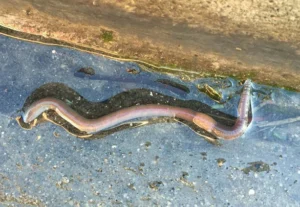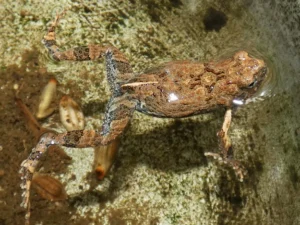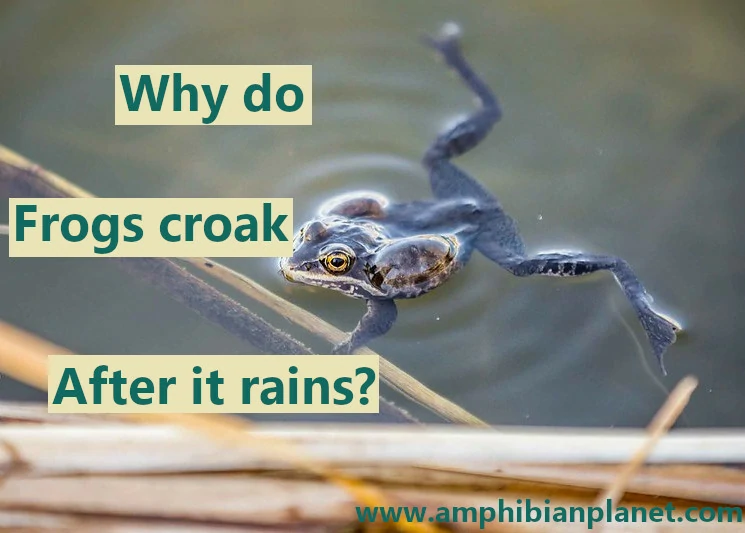Frogs are amphibians, which means they live part of their lives in water and part on land. Many frogs love to hang around ponds and other freshwater bodies where they can hydrate, and keep their skins moist. In rainy weather, it’s common to hear frogs croaking, as they venture further away from their typical habitats.
Frogs croak after it rains because the cool, wet environment stimulates their breeding instincts. The loud croaking you hear is typically coming from male frogs trying to attract a female with whom mate. Females move towards croaking males, and select the one they prefer based on their calls.
Rain creates puddles, floods ditches, and fills ephemeral ponds and other water bodies where frogs can lay their eggs, and their tadpoles can develop.
In addition, worms, snails, slugs, and many bugs are more plentiful after it rains, so frogs will come out to feed.
Rain Creates a Humid Environment
Frogs love cool, humid environments. When it rains, the weather is usually cloudy, and moist – creating the perfect environment for frogs to come out, and wander further away from their usual habitats.
Frogs have permeable skin that they keep constantly moist by secreting a mucous coating.
The humid weather, and higher moisture content in the air – after it rains, means frogs can come out and leap around without worrying about their skins drying out.
In addition, some predators such as birds, are less likely to be active in rainy weather, creating a safer environment for frogs to croak and look for mates.
Frogs Can Find Food More Easily in the Rain
When it rains, snails & slugs come out, and lots of earthworms come to the surface. Exposed earthworms or snails are an easy meal for a hungry frog.
If you ever take time to “dissect” and inspect the droppings of frogs, during the wet season, you may find undigested, broken-up snail shells.

Also, raindrops often hit flying bugs along the way, which knocks them out of the air and sends them to the ground. This makes them easy targets for frogs.
Rain Signals the Mating Season for Frogs
The breeding season for frogs is largely stimulated by rainfall, higher temperatures, and the availability of food.
When it rains, the wet, cool environment, and increased availability of food, creates the perfect conditions for frogs to breed.
The croaking you hear after it rains is actually male frogs, trying to attract female frogs of the same species so they can mate.
Each frog species has a different call and female frogs will only be attracted to the call of their own species.
When females are ready to mate, they will move towards calling males, and pick the male that they prefer.

In addition, rain fills up ditches and temporal ponds, where frogs can lay their eggs.
The Females of Some Frog Species Can “Filter Out” the Calls of Males From Other Species
It’s common for males of so many frog species to call from the same pond, trying to attract potential mates. Homing in on the right males can be a challenge for female frogs.
However, research has shown that the females of some frog species such as the American green tree frog, can make their eardrums less sensitive to the croaks of other species. They do this by simply inflating their lungs.
The extra vibrations of the lungs cancel out sounds of the same frequency at the eardrum, reducing sensitivity.
This decrease in sensitivity falls just between the two most prominent frequencies of a male green tree frog’s croak, so it does not affect the female’s ability to hear her own species.
Frogs Can Migrate to Their Breeding Sites After It Rains
On the first warm, rainy night of spring, the rain lures out hibernating frogs (such as wood frogs & spring peepers), and salamanders.
Once they emerge, frogs will migrate to wetlands with deep enough water where they can mate and lay their eggs. This mass migration is often referred to as “the big night”.
In some towns, people close roads and gather to watch thousands of frogs and salamanders on their breeding migration.
During this migration, frogs can travel significant distances, sometimes up to half a mile.
Male Frogs Croak to Defend Their Territory
In the breeding season, male frogs often form temporary territories to attract females, which they defend from other males. These territories usually occupy the immediate area around an individual.
Breeding male frogs will defend the boundaries of their territories, and scare off intruders by using a variety of calls. Some frogs will even fight intruding males.
Research has shown that male frogs of many species can tell the difference between their established neighbors, and unfamiliar strangers. This helps them avoid aggressive encounters with male frogs that hold territory nearby.
Frogs Can Breathe Easily When It Rains
Although frogs have lungs, they also breathe through their skin and thin membranes in their mouth and throat to get extra oxygen.
The skin contains a large network of capillaries and other blood vessels close to the surface. The oxygen that comes in contact with their skin and membranes is absorbed into the bloodstream via diffusion.
At the same time, carbon dioxide from the bloodstream passes through the skin and membranes and is diffused into the atmosphere.
This process of “skin breathing” is known as cutaneous respiration, and is very similar to what happens inside of our lungs.
To efficiently breathe, frogs have to keep their skin constantly moist. They can only absorb oxygen through their skin if the skin stays moist. If it dries up, they can suffocate and die.
The high environmental humidity in rainy weather means frogs can breathe easily and efficiently, without their skin drying out.
Frogs Can Cool Off in Rainwater
Frogs are ectothermic (cold-blooded) animals, which means they cannot regulate their body temperature. Their body temperature changes with that of their surroundings.
When it’s warm, their bodies soak up the heat, and their body temperature rises. When it’s cooler, their body temperature falls.
In other words, they depend on their environment to keep them comfortably cool or warm.
As the temperature changes at different times of day and night, they move around in their environment to regulate their body heat.
When their body temperature is low, they move into the sun to warm up, when it is high, they move to the shade or cool water to cool down.
During the winter, frogs will hibernate (technically, they brumate), to protect themselves from the freezing temperatures.
In the summer, if the weather gets too harsh, frogs will find a cool, moist place and estivate (think of it as some sort of ‘summer hibernation’) as they wait for the rain to come and the temperatures to drop.
When the summer rain finally comes, frogs will emerge from estivation, and come out to cool themselves by swimming in the puddles. This can be very refreshing, especially for frogs that don’t live near a pond or another body of water where they can swim in.
Sometimes, Predators seek out Croaking Frogs
When frogs croak, female frogs are not the only ones listening – many predators are also drawn to the calls.
For example, Túngara frogs, found in Middle, Central, and South America, are often preyed on by bats which locate them by homing in on their mating calls.

In addition, flies called midges, find their way to Túngara frogs by “intercepting” their mating calls. Midges feed on the blood of the frogs but also carry diseases and parasites, which they frequently transmit to frogs.
To avoid predation, the males of some frog species, such as the American green tree frog, will choose to remain silent when looking for mates (these are called ‘satellites’).
Instead, these frogs will intercept the calls of nearby males, and mate with approaching females. This is known as “sexual parasitism“.
Doing this enables satellite males to conserve energy, and avoid attracting the attention of predators.
Commonly Asked Questions:
Why do frogs croak before it rains? Frogs croak before it rains because there is higher moisture in the air. In addition, the cloud cover, and change in temperature just before it rains, means frogs can come out of their hiding spots, without the fear of overheating or, their skin drying out.
Do female frogs croak? In most frog species, it is the males who croak to attract females. Female vocalizations are typically very quiet and can be inaudible amongst the chorus of calling males. However, the females of some species, such as the smooth guardian frog, croak too, in an attempt to attract males to mate with
Why do frogs suddenly stop croaking? Frogs will stop croaking when they see a predator around. Female frogs aren’t the only ones listening – many predators are also drawn to the calls. If you ever take time, to approach an area where you hear a croaking frog, you will probably notice that the frog stops croaking when you get closer.
Why do frogs croak at the same time? Frogs croak at the same time, partly to reduce the risk of being singled out by a predator. A single frog croaking stands out and can be easily located by birds, snakes, and many other predators. However, many predators will have a harder time finding one frog from a chorus of hundreds of calling males.
Photo credit: Monikah Wiseman (CC BY-ND 2.0).


